8 tips to maximize grocery locker operational efficiency
Unlocking the door to efficiency and ROI.
Using grocery lockers is increasingly becoming a popular choice to provide a profitable, flexible, consumer-friendly and safe ways to provide at–store pickup. In early 2021 it was reported that grocery lockers have become the fastest growing grocery last mile solution.
Many are so compact that they can fit to the side of a small shop. But although they may be relatively small, they are mighty when it comes to order volumes. We are seeing some grocery retailers using a relatively small setup with around 60 of a mix of frozen, chilled and ambient compartments, are peaking at almost 200 orders a day with 8 collection slots. Many retailers are using more slots, bigger locker systems and innovating further.
With a larger setup shifting 300 orders a day is perfectly possible – if not more (that’s 1.5 million orders a week Monday to Friday for a store network of 1,000). And that is without the additional costs of home delivery.
Obviously, this is a hypothetical situation dependent on the demand. But the point is that grocery lockers can sustain a surprisingly high level of productivity if their operational capacity is being maximized.
They might look compact, but they pack a substantial punch in terms of their volume potential, flexibility and additional benefits that might not be obvious at first glance.
If you want to learn more about StrongPoint’s Click & Collect Grocery Lockers, click here.
8 things that a grocery retailer can do to squeeze operational efficiency from grocery lockers
![]()
1. Maximize the efficiency of order loading
Although it is very easy and fast to fill a locker, store workers must at times compete with customers for access. Carving out time for order replenishment means reducing the time slot availability, thus reducing the efficiency of the solution.
Ensuring that the locker software features a digital and mobile solution for store workers so they can load orders from their phone or work handheld device can significantly increase the overall efficiency.
Store workers can keep social distance from customers to ensure they don’t interrupt the customer experience and frees up the terminal for customers.
2. Delivery slots as late and early as possible and 24/7
The number of delivery slots is going to instantly impact the efficiency of the locker. Having more slots per day means more orders going through the lockers. But obviously smaller slot windows mean less flexibility for the end customer.
We are seeing some grocery retailers who are able to do almost 200 orders a day with just 8 time slots – but some are peaking at much higher slot levels, even as high as 12 a day. Everything depends on the locker location and surrounding area, the more urban densely packed the more the opportunity to have more pickup slots.

3. Dynamic pricing and dynamic pickup windows
We are seeing that certain times of the day attract the more customers. Our recommendation is to segment these into smaller time windows. According to our insight’s grocery retailers are usually seeing inconsistent levels of demand over the week with a big peak on one particular day.
They are also seeing similar trends over a single day as there is usually a specific time of day where most people want to pick up their groceries. This means that you should experiment on the length of the pickup window. Just how short a slot is possible could be is going to depend on local circumstances and perhaps basket sizes.
But it is good to test to see what is the most optimal – you may be surprised at just how small of a window is possible. In addition, this might help to smooth out demand to less busy times with customer who would normally pick the peak hours opting to go for a bigger window but at a less busy time.
4. Maximize the speed of order picking
The number of orders you can process depends on the speed of your pickers. The faster you can get this done the more orders you can process and provide via the lockers. Don’t underestimate the power of picking to boost the number of locker-based orders.
5. Go mobile (lockers)
Mobile grocery lockers that do not need a building permit offer a way for grocery retailers to increase capacity at peak periods or where there is a short-term or temporary demand, for example a popular holiday location or university campuses where demand is concentrated in terms times.

6. Use them as a collection point for on-demand food and grocery delivery app couriers
Grocery lockers provide an extremely easy and fast way to integrate with the fast-growing number of on-demand food delivery app companies that now provide groceries. The delivery couriers can pick up orders from lockers making it easier and faster.
7. Use lockers as a storage zone
We are seeing a trend for stores to use the lockers as combination of pick-up points and storage. So smaller stores with less space for storing the orders will pick orders to be stored directly into the locker. This eliminates the need for any additional in-store infrastructure.
8. Ensure a seamless pick-up of age restricted items
Age restricted items can be a hassle and cause delays for both staff and customers. Making sure that when you do have a customer with an age-restricted item waiting for them, you need to ensure your locker software includes the fastest and most seamless way to get this done.
StrongPoint has partnered with a leading AI-based age verification company that makes this process redundant as the customer can verify their own age. But even without this functionality ensuring this step in the process is as fast and seamless as possible can shave off additional labour time.
Do you want more information about how to utilize grocery lockers for your grocery store/chain? Just CONTACT US HERE and we will be happy to help!